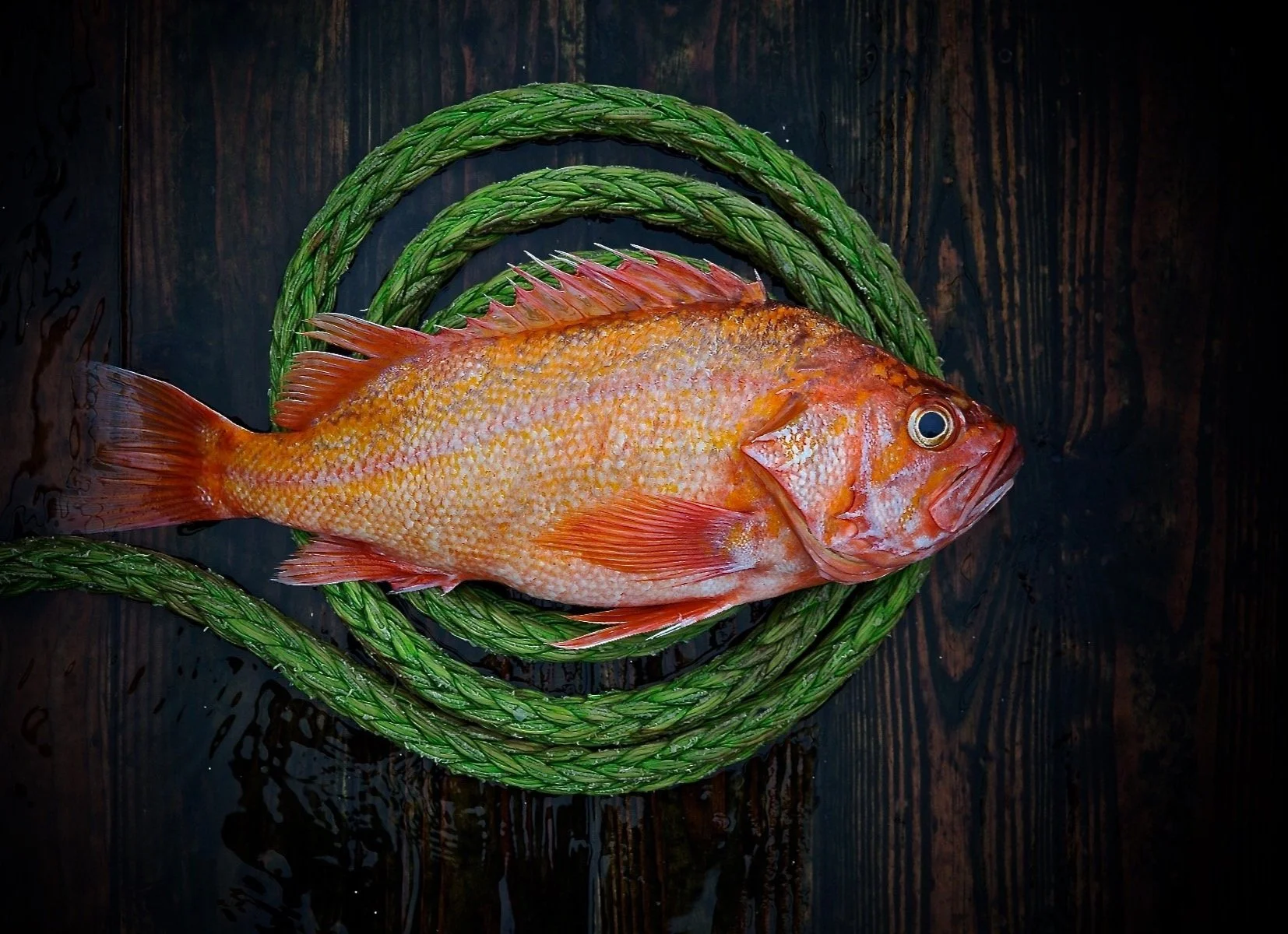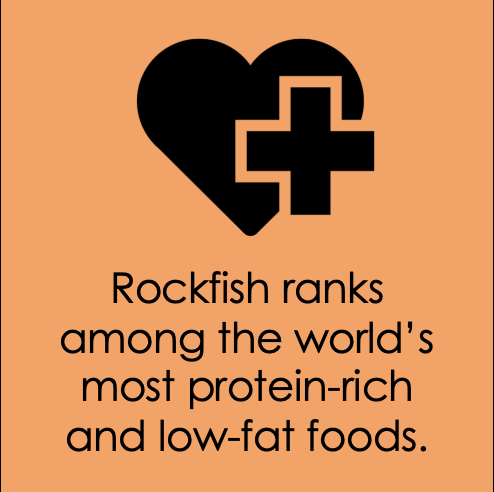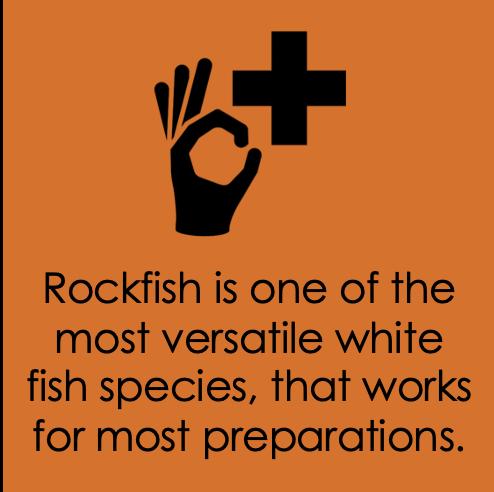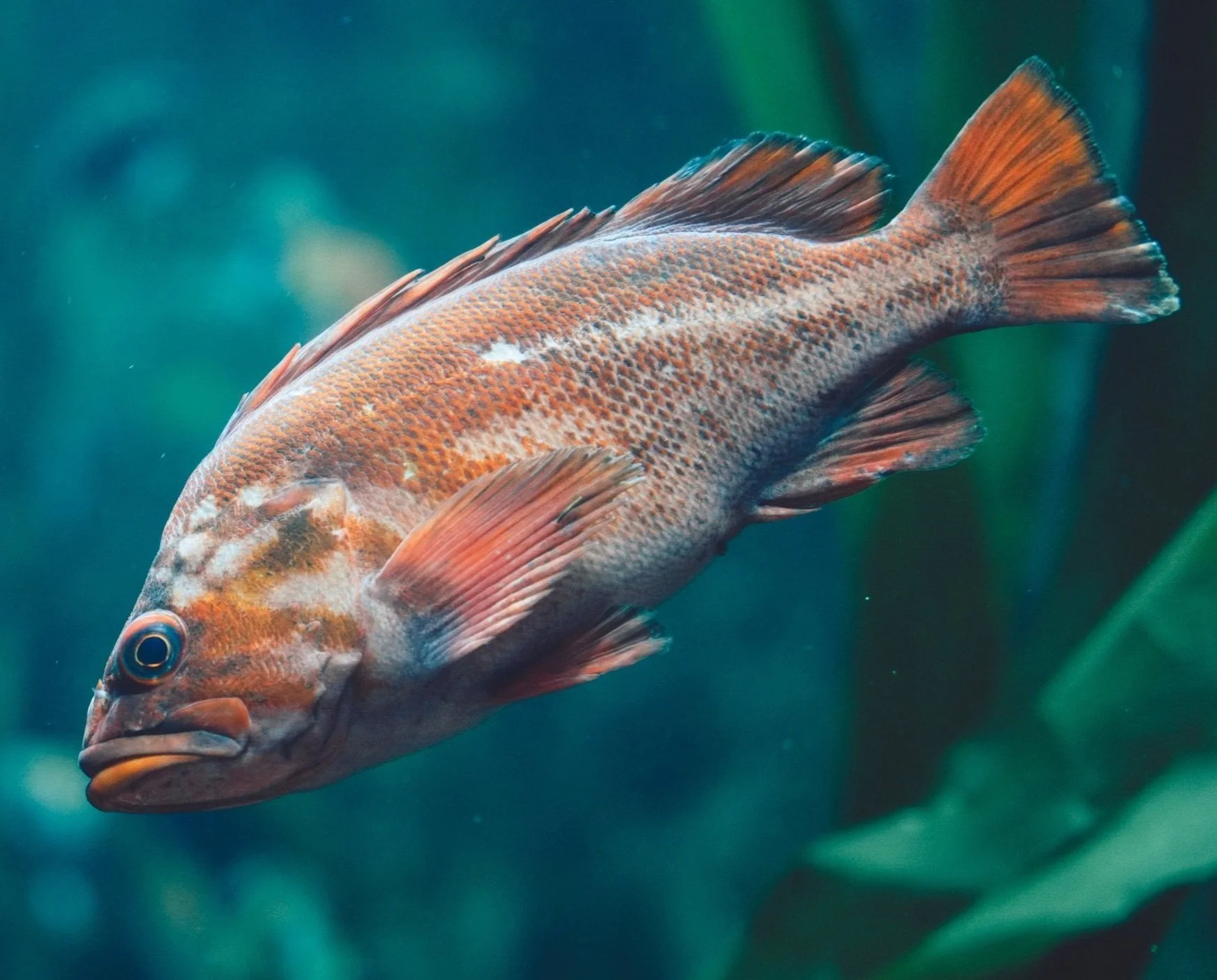PACIFIC ROCKFISH - FISH SPECIES FEATURE
What is a Rockfish?
Pacific Rockfish (Sebastes spp.) are also known as Rock Cod or Pacific Snapper, though biologically they are neither cod nor snappers. Rockfish is not a single species, but a whole genus encompassing 70+ different sub-species of every imaginable coloring. They are caught wild along the entire West Coast of the United States from California to Alaska, and get their name from living in rocky habitats. Boasting healthy and abundant populations, the 10 most commercially important species of rockfish are certified sustainable by the Marine Stewardship Council and rated a "Best Choice" by Seafood Watch.
Rockfish are THE fish to use in tacos or fish & chips, but they are amazingly versatile mild white fish species that are suitable for most preparation methods, and that make a great canvas for different flavors, sauces and cuisines. Rockfish is a lean white fish with a mild, slightly sweet flavor with a medium-firm texture and medium flakes, that is a great substitute for cod, tilapia or swai. Nutritionally, Rockfish stand out for being extremely high in protein, and rich in mirconutrients like Omega-3, Vitamin B12, Potassium and Selenium.
Rockfish Quick Facts
Rockfish Biology
Pacific Rockfish is not one species, but describes a whole genus (Sebastes spp.) that has over 70 different individual species of every imaginable color and pattern. Rockfish get their name from the rocky habitats they inhabit and are known for their distinctive, spiny fins.
Pacific Rockfish are common all along the U.S. West Coast, from Baja to Alaska. They typically inhabiting rocky reefs and kelp forests from shallow waters down to depths of over 1,000 feet. Fishery managers categorize rockfish species into near-shore (mainly for recreational fishing), midwater complex (Yellowtail, Widow) and deep bottom complex (Chilipepper, Boccacio, Thornyheads).
Some Rockfish species are very long-lived and can reach up to 100yrs of age and grow to 40 inches in length, however most commercially-caught Rockfish species tend to be fast-growing species with shorter lifespans. Rockfish are predators that eat a variety of marine life such as small fish, squid, and crustaceans.
Rockfish Sustainability
Wild & Natural
Pacific Rockfish is a wild-caught fish species. This means that it requires no arable land, no precious fresh water, nor any fertilizer, pesticides, polluting chemicals, or antibiotics to produce this excellent protein source.
Healthy and Abundant fish population
West Coast wild-caught Rockfish is among the most positive sustainability success stories around. Following declines in the species' population levels during the 1990s and receiving a federal disaster declaration in 2000, Rockfish populations have bounced back to great abundance levels thanks to a total commitment to sustainability.
Well-managed fishery
Pacific Rockfish is subject to a rigorous science-driven management process through the federally appointed Pacific Fishery Management Council that ensures continued abundance in the future. This entails scientifically set limits on total catch, and limitations on when, where, and how fishing can occur (i.e., avoiding spawning seasons, protecting sensitive habitats, and using gear that minimizes accidental by-catch).
Keeping it local
While the average seafood product consumed in the United States clocks up over 5,000 food miles, Pacific Rockfish are caught and processed locally on the West Coast. Keeping it local not only minimizes food miles and their carbon footprint, but also maximizes product freshness and quality.
100% monitored FISHERY
Rockfish fishermen are 100% accountable for their catch. All West Coast fishermen who catch Rockfish with trawl methods have an independent observer and/or camera system on board on every single trip to ensure compliance and complete record-keeping.
Independently certified SUSTAINABLE
Since 2014, Rockfish caught in California, Oregon, or Washington have been certified sustainable by the Marine Stewardship Council, the gold standard for wild sustainable fish. Moreover, several species of rockfish are rated as a green "Best Choice" by Seafood Watch.
Rockfish Nutritional Content
Nutritionally, Pacific Rockfish is low in fat (0.5g/100g) and exceptionally high in protein (20g/100g), and comes in at only 90 calories per 100g raw fillet. This means Rockfish has an impressive protein content of 92-95%, depending on species, making this an extremely calorie-efficient lean source of protein.
To provide some comparison, calorie for calorie, Rockfish has twice as much protein as wild King Salmon or lean skirt steak, and twice as much B-12 than a T-bone steak. Impressively, despite being such a lean fish, Rockfish offers high levels of Omega-3. In fact, Pacific Rockfish provides 3.5x more Omega-3 than Tilapia or Yellowfin Tuna. Moreover, Pacific Rockfish is packed with many important micronutrients; such as Selenium, Phosphorous and Potassium.
Learn more about how Rockfish compares to other foods here.




Rockfish Taste & Cooking
Pacific Rockfish is one of the most versatile white fish species around; there really aren’t many dishes Rockfish wouldn’t be suitable for. It’s a fantastic canvas for many different flavors, sauces and cuisines.
Taste: Rockfish is a lean white fish with a mild, slightly sweet flavor with a medium-firm texture and medium flakes. Pacific Rockfish is similar in taste to cod and haddock, and is a tastier, nutritious and sustainable substitute for farmed tilapia or swai.
Preparation Method: Pacific Rockfish a versatile fish that works well for most preparation methods, but it’s particularly great for pan-frying, baking, or deep-frying for fish & chips or fish tacos. However, Rockfish is also great for low-calorie preparations like crudo, sashimi, or steaming. For grilling we recommend to either grill Rockfish whole, or to grill fillets with the skin on. Rockfish cooks up quickly - be sure not to overcook it.
How to cook Rockfish
How to fillet a Rockfish, demonstrated by star chef Michael Cimarusti.
How to fillet a Rockfish, demonstrated by fishmonger Hans Haveman.
How to prepare and cook a Rockfish whole.
How to butterfly BBQ a whole Rockfish
How to grill a Rockfish perfectly, demonstrated by star chef Michael Cimarusti.
Rockfish Recipes
Recipe: Rockfish & Grits - a delicious PNW take on a Southern dish.
Easy Recipe: Southern-Fried Rockfish Po'boy Sandwich
Recipe: Western Bacon Rockfish Burger
How to make Rockfish Fish & Chips
Recipe for Rockfish Nigiri
Recipe for Rockfish Ceviche with Stone Fruit
Recipe: Rockfish Crudo with Japanese Flavors
Recipe: Rockfish Crudo - Baja style
Recipe: Rockfish Crudo with Thai Flavors
Recipe: Pickled Rockfish Rollmops
Common Questions
-
Pacific Rockfish is widely available in supermarkets, fish markets, and restaurants along the West Coast of the US, and increasingly throughout the US. We have provided a list of markets, online suppliers, and restaurants that focus on these local sustainable species. Check out our Retail & Restaurant Guide>>
-
No. Pacific Rockfish is one of the most affordable white fish species, especially considering that this species is wild-caught, MSC-certified sustainable, caught and processed in the US by local fishing families. Pacific Rockfish typically costs between $8 to $15 per pound, which translates to just $2 - $3.50 for a 4oz portion. Though prices can vary based on season and location.
-
Pacific Rockfish are a diverse group of fish species from the Sebastes genus, found along the Pacific Coast. They are known for their distinctive, spiny fins and variable colors.
-
Yes, Pacific Rockfish is a very healthy seafood choice. Pacific Rockfish is exceptionally high in protein (20g/100g) and low in fat (0.5g/100g), and comes in at only 90 calories per 100g raw fillet. This means Rockfish has an impressive protein content of 92-95%, which is twice as high as wild king salmon or lean skirt steak.
Rockfish also offers great levels of B-12 (twice that of a T-bone steak), Omega-3 (3.5x more than Tilapia or Tuna), as well as Selenium, Phosphorous and Potassium.
Learn more about how Rockfish compares to other foods here.
-
Protein content in Rockfish varies slightly by species. But all Pacific Rockfish are exceptionally high in protein (20g/100g) and low in fat (0.5g/100g), and come in at only 90 calories per 100g raw fillet. This means Rockfish has an impressive protein content of 92-95%, depending on species, which is higher than egg whites, chicken breast, whey protein powder or steak.
Pacific Rockfish is exceptionally high in protein (20g/100g) and low in fat (0.5g/100g), and comes in at only 90 calories per 100g raw fillet. This means Rockfish has an impressive protein content of 92-95%, which is twice as high as wild king salmon or lean skirt steak.
Learn more about how Rockfish protein content compares to other foods here.
-
Pacific Rockfish is one of the most versatile white fish species around; there really aren’t many dishes Rockfish wouldn’t be suitable for. Rockfish can be used for any cod recipes, tilapia recipes, or haddock recipes.
Historically, Rockfish is THE fish species to use in fish & chips and fish tacos. Rockfish is particularly great for pan-frying, baking, but also works great for low-calorie preparations like crudo, sashimi, or ceviche. Try out some of the delicious rockfish recipes on this page!
-
No, Pacific Rockfish are NOT poisonous! Do not confuse harmless Rockfish with Stonefish, the most venomous fish in the world, whose sting can be fatal to humans.












































